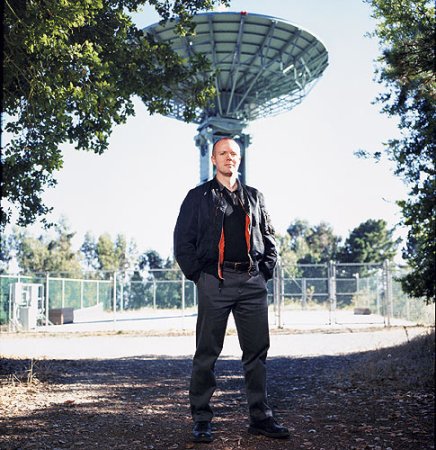

Ever since he returned from the ultimate getaway–six months aboard space station Mir–Alexander Poleschuk has not had much patience for the mundane. Even today, 10 years later, there’s a kind of contained restlessness about the former cosmonaut as he sits, drinking tea and fingering his cigarette pack, in a Toyota dealership on the bleak, block-housing-lined outskirts of Moscow, waiting for his car to emerge from the service bay.
A little knot of men–the new Russian entrepreneurial class–stand elbow to elbow at the window, like dads at day care, keeping an anxious eye on their gleaming Corollas. Nobody seems to recognize Poleschuk, 51 years old with a push-broom mustache, wearing a Technicolor sweater, and therefore nobody thinks to ask, “Hold on: Shouldn’t cosmonauts–whose mechanical miracles in zero G kept the wheezing Mir going for 15 years–be able to fix their own cars?”
“For me a car is a means of transportation, not a means of killing time,” Poleschuk says, green eyes shining. It’s a riff on the old Soviet adage, “A car is a means of transportation, not a means of luxury”–words that, in the new Russia, with its growing class of capitalists, are starting to make less and less sense.
Poleschuk today is a different man from the one who went to space. In low Earth orbit something inside him was recalibrated forever. “When you’ve been in extreme conditions, the psyche changes,” he says. “The Earth did not seem as big as I thought. You can see evidence of ecological problems, and you realize how man’s will can be both creative and destructive. You feel like a tangible particle of space. You no longer belong where you were born.”
Spacephiles will remember Poleschuk as the flight engineer on the 13th Mir mission, a six-month space voyage in 1993 during which he performed 10 hours’ worth of space walks to test the docking assembly that would be used on nine subsequent space shuttle visits. The mission was Poleschuk’s first and last; the breakup of the Soviet Union wreaked havoc on Soyuz seating assignments, and though he later was in line to fly to the International Space Station, “I decided that there are many younger cosmonauts waiting to fly. Plus, I have enough work as it is.”
There is one archetypal workplace in the Russian space program, and Poleschuk has punched his card there for a quarter century. That place is RSC Energia, the neocortex of Russia’s national space strategy. A senior test engineer in Energia’s design bureau, Poleschuk oversees what, in space, he performed–on-the-fly, nuts-and-bolts repair and assembly techniques. There may be no one in the Russian space program with more detailed, firsthand mechanical knowledge.
When historians list the motivations that have nudged human beings into space, national pride is always near the top. The architect of U.S. space strategy was Wernher von Braun, who had designed rockets for the Nazis. (He was so far ahead of his time that when the Russians found one of his V-2 rockets after the war, awestruck engineers described it as “that which is not possible.”) Von Braun’s most obvious legacy, besides boot prints on the Moon, is the credo that space exploration is one of those projects, like interstate highways or nuclear power, that are too big and fraught to be left to the private sector. The Soviet Union, where private enterprise was until a decade ago practically nil, was von Braunian right out of the chute. Their man was Sergei Pavlovich Korolev (1907â€1966), founder of Energia.
Though it may be an exaggeration to say Korolev single-handedly masterminded the Soviet space program (it was a Byzantine system, full of competing programs led by men with their hands on different political levers), his thumbprints were all over the great Soviet firsts: the first satellite, first man in space, first space walk, first woman in space. (And then, posthumously: the first space station, first docking, first catastrophe in space.) All this despite punishing obstacles: nepotism, technological constraints (a potent image is of Korolev’s engineers, early in the space race, working out rocket-trajectory calculations by hand), the gross inefficiency of two competing Soviet Moon programs, and such institutionalized paranoia that nobody knew the identity of Russia’s chief designer of space systems until after Korolev was in the ground.
“He had such a wide range of sufferings and joys it’s unbelievable,” says Poleschuk, who owes Korolev a personal debt. It was Korolev who, after Yuri Gagarin’s historic flight in 1961, promoted the idea that the cosmonaut ranks should include engineers and scientists, not just military test pilots. And then, at the apogee of the Soviet space program’s power, Korolev died of cancer and everything changed. At that moment a gap appeared between the Russians’ goals in space and their ability to achieve them. If Korolev had lived? “We would get the Moon,” Poleschuk says. “There should be no doubt about it.”
The overhead light suddenly winks out in the Moscow car showroom, and Poleschuk springs reflexively from his chair to deal with the problem, as if he were still onboard Mir. Some people at a nearby table have been eavesdropping on him; their expressions are hard to read. These folks are certainly not awestruck–as they would surely have been 20 years ago, when Soviet schoolkids knew the names of every cosmonaut, past and present. Rather, they seem vaguely curious, like teenagers watching a show on the Discovery Channel that’s marginally more interesting than their homework.
In Russia–as in the United States –astronauts have lost much of their heroic luster. “In my day, we in the aerospace field were not only enthusiasts, we were warmed by the state,” Poleschuk says (warmed with a healthy paycheck, he means). When young Russians go into space engineering today, it’s not because they dream of becoming cosmonauts, or even because they love space, Poleschuk says: It’s that they “have the understanding that this high-tech training could be useful in other areas.” He takes a sip of black tea. “The youth have lost the notion that they can satisfy their pride for the state through their work.”
It’s a tough time to be a von Braunian–or a Korolevian–in Russia.
Every Wednesday at Energia’s headquarters, department heads meet and, one by one, they offer up their problems. “The economists say there’s no money,” Poleschuk says, “and the people on the factory floor complain about the shortage of parts.” The post-Soviet economic collapse abruptly transformed the space program from state-funded to unfunded, sending independent Russia lurching reluctantly into the marketplace. Energia is now a semiprivate company, half stockholder-owned–a decision that, no matter how ideologically distasteful, preserved it through a tough decade. Even Energia’s historic archrival, Khrunichev–manufacturer of the workhorse Proton rocket and the last redoubt of full state sponsorship–has been forced to court international partners like Lockheed Martin and Boeing.
Russia now finds itself making Mephistophelian deals. It routinely sells its hard-won expertise to the highest bidder–one week putting would-be Soyuz passenger Lance Bass through medical tests at the Institute for Biomedical Problems, the next week spinning a European astronaut in the centrifuge at the Gagarin Cosmonauts Training Center in Star City. The image of the Russian brain-for-hire has become a clich. In the movie Armageddon, a cosmonaut fixes a problem on the space station by banging on an instrument console with a hammer. “That’ll be a thousand dollars,” he declares. “A thousand dollars for one bang of a hammer?” asks his American colleague, aghast. “Da. One dollar for the bang, 999 dollars for knowing where to bang.”
Russians know where to bang. But that may be small consolation to senior engineers who, once pleasantly “warmed by the state,” now find themselves earning a quarter the salary of a cab driver on the night shift in Pushkin Square. Everywhere there are reminders that the great Korolevian era is over. ICBMs that once thrummed across Red Square on parade day now launch foreign satellites at market prices. Venerable institutions like Cosmonautics magazine are being kept alive by private money. And when journalists wish to interview old-guard cosmonauts, those cosmonauts will sometimes ask to be paid–assuming that everything is negotiable in the new market economy, including their own recollections.
And so Russia has morphed from the world’s purest state-run space program to the world’s most commercial space program. But it would not be correct to say that when the Soviet Union died in 1991 the von Braunian impulse died with it. Russian space scientists have been courted by the United States, France and Canada, at wages befitting top scientists rather than fry cooks. Some did leave Energia, but the brain drain was not as comprehensive as one might expect. “There are people who will never leave the aerospace industry even though they’re offered much more elsewhere,” Poleschuk says. “I have great respect for these people.”
At Energia, engineers still have big plans. “We’re working on Mars flights, we’re talking about creating Moon bases, we’re talking about creating observation posts at the LaGrange points to detect asteroids, and to build interplanetary factories at these points,” Poleschuk says. The Institute for Biomedical Problems is planning a $2 million isolation-chamber experiment (funded by the European Space Agency): In 2006 a handful of scientists will be sent into the 450-square-foot chamber for a year and a half–a trial run to simulate how a crew would experience a mission to Mars.
A Mars mission isn’t at the top of the to-do list in a nation where many people aren’t getting properly fed, but as far as many Russians are concerned, the big von Braunian dreams are the only ones worth having. “I am a patriot of the idea of space conquest,” says Poleschuk.
What of the O’Neillian cowboys trying to open up space with private investments? Dennis Pivnyk, the prow-jawed deputy director of Khrunichev, shakes his head. “We have to lean on the state, on the government,” he says. “We cannot finance space from commercial sources. We. Can. Not.”
OK, then, what about a national program, but something less, um, conquistadorial. More contemplative. How about the Saganite idea of virtually exploring Mars? “Maybe eventually, with artificial intelligence, we’ll be able to replace human beings,” Poleschuk says. “Maybe even to go to Mars. But then, why would you? Why should we go to Mars virtually?” Because it’s safer? “The exaggerated safety demand is growing out of proportion in the press,” Poleschuk says, reddening. “The states are listening way too much to people lying on the sofa. These people are dummies, in the dark. This is typical of all jaded civilizations.”












